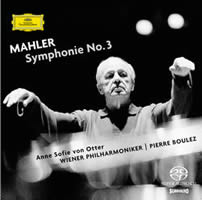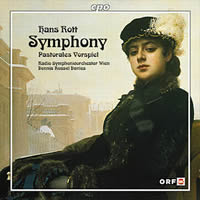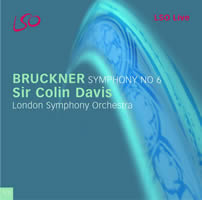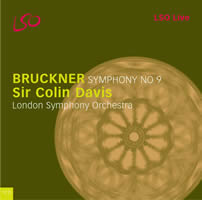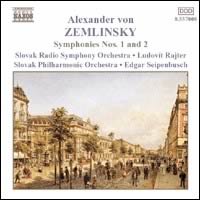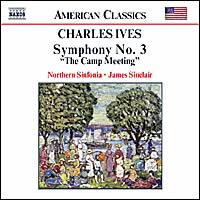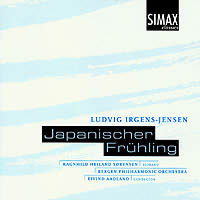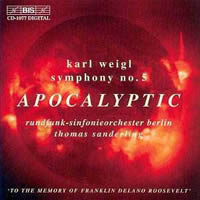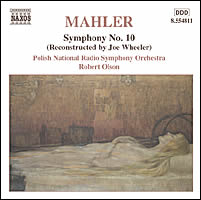Echt und Ersatz: Mahler, Bruckner, Rott, Zemlinsky, et al.
|
Grant Chu Covell [August 2003.] Kismet or coincidence? Without realizing it, I began these remarks on Mahler’s birthday. In high school, I was obsessed with the symphonies. Berg’s Three Pieces for Orchestra (on a scratched Robert Craft LP from a classroom bookcase) put me on the road to recovery. Xenakis and Lachenmann lay not far ahead. A lingering fondness for Mahler (1860-1911) has broadened into a fascination for Austro-Germanic symphonies of the late 19th and early 20th centuries. Raff (1822-82), Bruckner (1824-96) and Brahms (1833-97) were Mahler’s seniors. Of these, we’ll look briefly at two new Bruckner releases. Rott (1858-84) and Zemlinsky (1871-1942) wrote memorable music, but I can’t resist including as well a few who crossed paths with Mahler, literally or by way of influence: Ives (1874-1954), Weigl (1881-1949) and Irgens-Jensen (1894-1969). Furtwängler’s Second (1945), would be in good company here, whereas Richard Strauss (1864-1949), a very different type of symphonist, will not be joining our party.
Gustav MAHLER: Symphony No. 3 (1895-6). Anne Sofie von Otter (mezz.); Wiener Philharmoniker, Pierre Boulez (cond.). DG 289 474 038-2 (http://www.deutschegrammophon.com/). With Berg just ’round the corner, it’s been easier to tackle Boulez’s explorations of the purely orchestral Mahler symphonies, especially the Sixth, Seventh and Ninth. I can’t envision the man who demanded the torching of all opera houses lolling about in a Biedermeier salon or having a go at Des Knaben Wunderhorn. It’s no surprise that DG’s ongoing series concludes with the choral symphonies. Boulez’s take on Mahler relative to other conductors is like switching from incandescent to fluorescent lighting or catching a favorite movie in a restored print. Consider the arguments a colorized version of Marcel Carné’s Children of Paradise would provoke. Just as Mahler and Boulez have a limited set of fans, of the few who have seen this film, more than a few can’t stand it. In the 33:34 first movement (I still lurch expectantly to turn over an LP), the famous trumpet fanfare and the subsequent bassoon trills, string tremolos, low string scales and timpani figures are laid out as if in a packing list. Visconti could never have used this for Death in Venice. The distinctive trumpet call is bleached of sentimentality. It’s really no more than an arpeggio that doesn’t quite resolve. Nothing sappy or grandiose. When Mahler does go over the top, e.g., when the first movement’s marching band takes over, it’s embarrassing. Boulez and the Viennese give a minimally sentimental and untraditionally refined Mahler Third. Boulez is at pains to remind us that the 1896 Mahler was not a mature orchestrator. Compared to the Ninth’s contrapuntal mastery, the Third is well-instrumented piano writing. With Boulez, tone colors are discrete and transitions stark, a cubist buffet of delimited melodies and moods. The third movement’s conclusion is matter-of-fact. Themes come together without rushing, the tempo slows only mildly for the final appearance of the idyllic music, and then it’s over absent the traditional elongation of the final chord. Anne Sofie von Otter is luminescent in the first vocal appearance (fourth movement). It’s beautiful music coolly done. She alone is worth the trip. I went to the score to see if the intermittent oboe really had a portamento indicated where Boulez interprets Mahler’s “rustic” sound. The final Adagio, usually a good place for grandstanding and gushing, doesn’t slack off. Boulez’s restraint mirrors Mahler’s sparsely written pages. The Viennese exhibit superb balance and intonation. The opening horns are close to perfection. The second and third movements, romantic instrumental miniatures on steroids, are exceptionally well articulated. Boulez fans will approve.
Hans ROTT: Symphony in E Major (1878-80); Pastorales Vorspiel (1877-80). Radio Symphonieorchester Wien, Dennis Russell Davies. cpo 999 854-2 (http://www.cpo.de/). Distributed in the US by Naxos (http://www.naxos.com/). The missing link! A symphony from one of Mahler’s schoolmates, whom Mahler thought was a genius! Bruckner’s best pupil! But Rott went nuts and was locked up for his last days, using the manuscript of a string sextet for basic hygiene. He had been committed after a few suicide attempts and a notable outburst on a train. A fellow passenger was about to light a cigar when Rott accosted him, claiming that Brahms had loaded the train with dynamite. (Maybe that’s why Philip Hale quipped “Exit in case of Brahms.”) Rott, Mahler, and an unstable fellow named Hugo Wolf were all classmates, by the way, and Bruckner wasn’t the most balanced individual either. When Rott’s manuscript was discovered in the 1980s, scholars claimed that this would shed new light on Mahler’s Wunderhorn years. There were lots of suggestions that Rott was the better composer (Mahler’s mother started that rumor in an unsupportive slap at her son), and that Mahler had taken advantage of Rott’s incapacity, pilfering his friend’s work. The symphony has its charms. Rott showed it to Brahms, who found it distressing, a freewheeling concoction that bridged himself (the “big” theme of his First) and Wagner. Some listeners may never make it past Rott’s wholesale indebtedness to Die Meistersinger. Apparently Rott was shaken by the elder composer’s dismissal. Brahms could be crass, especially if someone dared meld his style with that of the enemy. Several early Mahler trademarks are evident: melodies starting with upward fourths, harmonic progressions where the root moves in scales, climaxes over pedal points, etc. Delicate chord progressions from the first movement bear a startling resemblance to a similar spot in the opening movement of Mahler’s Sixth. Rott’s scherzo is especially akin to the Ländler movements of Mahler’s symphonies with their clustered thematic groups. Vivacious with all the naïveté of unbridled youth, it’s the most coherent and stunningly orchestrated movement. Once you get past sorting out the allusions and influences (there’s some Beethoven too: echoes of the Op. 28 piano sonata in the opening trumpet melody), you come to realize that this is a student work by a composer full of potential. Just as it would be hard to chart Wagner’s eventual career from his early symphonies and piano sonatas, we can’t possibly guess at what Rott might have become. As an interesting feature, each of the four movements is longer than the one before, suggesting an interest in cyclic forms, especially as the opening trumpet tune reappears. The last movement doesn’t quite bear up under its multiple endings and final fugue, and there’s an awful lot of triangle clanging in need of pruning. This recording is one of the better ones out there. The Cincinnati Philharmonia Orchestra with Gerhard Samuel on Hyperion CDA66366 plays earnestly, stumbling only over the symphony’s flaws. It’s hard to work with juvenilia, especially so potent an example. The lush sections, e.g., the second movement’s opening, are delicious. It helps that Davies promptly dispenses with the troublesome bits. It’s worth snapping this up for the Scherzo alone. Pastorales Vorspiel rounds off the disc. At nearly 16 minutes, it’s vastly inferior to the 55-minute symphony. I bet that string sextet was a lot like Brahms. [This reminds me of something Max Reger wrote to a critic. I may be misquoting slightly but I think I have the spirit of the thing. “I am in the smallest room in my house. Your review is before me. In a moment, it will be behind me.” And while we’re here, there’s Brahms’ famous cut at Bruch, who had just shown him a violin concerto. Apparently all Brahms could say was: “Very impressive paper. Where did you get it?” Ed.]
Anton BRUCKNER: Symphony No. 6 (1879-81). London Symphony Orchestra, Colin Davis (cond.). LSO Live LSO 0022 (http://www.lso.co.uk/). Distributed in the US by Harmonia Mundi (http://www.harmoniamundi.com/). Anton BRUCKNER: Symphony No. 9 (1887-96). London Symphony Orchestra, Colin Davis (cond.). LSO Live LSO 0023 (http://www.lso.co.uk/). Distributed in the US by Harmonia Mundi (http://www.harmoniamundi.com/). Davis finds features in Bruckner others have overlooked. (Solti and Jochum are the leaders of the cycles I’ve revisited.) Davis favors color over bombast, and I’ve come to enjoy these live performances more each time. Brass players love Bruckner because few other composers let ’em knock the ball out of the park. Davis tempers their enthusiasm, giving the winds, including the horns, a chance to shine. The Sixth is especially joyous, the last bars of its first movement a blissful keening rather than the more customary nail-hammering with its tendonitis-causing rhythm. Similarly, the Scherzo of the Ninth (that may or may not have inspired Holst when he penned “Mars”) is played briskly, its pounding rhythm subordinated to the dissonance of the surrounding chords and melodies. The last movement of the Sixth is not a patchwork of manic moods but rather a torrent of grand phrases leading to the climax. The London Symphony responds eagerly to Davis’ expansive phrasing. Gone is the urge to count my way. (You’re missing a little something if you’ve never felt the urge to count off the measures.) Bruckner labored on his Ninth for nine years, slaving away at it till the day he died. An insecure and obsessive reviser, forever tempted by the advice of friends, Bruckner could have easily passed the dreaded ninth-symphony mark several times over. The oppressive 28-minute opening movement threatens to collapse under its own weight. The hulking mood prevails in the Scherzo and the final Adagio, the contrived sunny ending of which provides a saccharine conclusion to the symphony Bruckner couldn’t finish. Davis doesn’t make of the Ninth a colossus; rather, he unearths a disturbing portrait. If you like your Bruckner pompous and intimidating, stay with Karajan. If it’s less godly revelations you’re after, go for Davis. The London Symphony Orchestra produces and markets its own inexpensive recordings. The band has already won awards for some Berlioz, and other prizes are inevitable. It’s amazing that they’ve released live performances of Bruckner, a rather courageous thing to do. I expect a cycle will emerge. I’ll take the Sixth over the Ninth, which Davis has made rather uncomfortable. I look forward to a Bruckner Fifth with its counterpoint and thrilling octave leaps.
Alexander von ZEMLINSKY: Symphony No. 1 in D minor (1892); Symphony No. 2 in B-flat (1897). Slovak Radio Symphony Orchestra (Bratislava), Ludovit Rajter (cond.); Slovak Philharmonic Orchestra, Edgar Seipenbusch (cond.). Naxos 8.557008 (http://www.naxos.com/). From its Marco Polo side of the house, Naxos has reissued these 1980s Zemlinsky symphony recordings. What Naxos calls the Second Symphony is the main attraction. Zemlinsky’s symphonies are often referred to without number. This is the first recording I’ve seen that numbers them. Sometimes the incomplete E-minor Symphony is listed as the first. The lively 41-minute B-flat Symphony, with its lack of sentimentality and pretension, has an affinity with Dvorak’s Sixth and Eighth, premiered in 1881 and 1890. Zemlinsky would frequently spice his melodies and accompaniments with repeated notes or dotted figures, and some works, such as the Lyric Symphony (1922-23), openly flirt with exotic sounds and harmonies. After an introduction, the B-flat’s first movement begins with an irresistible, soaring theme smartly developed. An efficient Scherzo follows, then a lyric Adagio, finished by a grand passacaglia-like finale that briefly brings back the first movement’s big theme. It’s memorable and hummable. Hearing this over the radio, you wouldn’t reach for the dial. Seipenbusch and the Slovak Philharmonic Orchestra are a match for the energy and interpretation of Chailly’s out-of-print London 421 644-2 (padded with Psalm 23). The Slovak ensemble’s elegance endows the symphony with a warmer, more diffuse glow. Zemlinsky’s place in history is overshadowed by his brother-in-law, Schoenberg, and fellow composer-conductor Mahler. Zemlinsky never forgave siren Alma for ditching him in favor of Gustav. The opera Die Zwerg chronicles his despondency. Zemlinsky’s music is more compact than Mahler’s or Bruckner’s, and less stodgy than Brahms. It sounds to me free of ego and literary pretension. You’d never guess these symphonies are contemporaneous with Strauss’ tone poems. With its consistency, original themes and evidence of a fully formed personality, what we have of the D-minor work, three movements written in his early 20s, surpasses Rott’s essay written at the same age. The initial movement is moody. The central Scherzo contrasts a sprightly theme against something more chest-thumping. The last movement is a grand, Romantic arch. Rajter and the Slovak Radio Symphony Orchestra of Bratislava confidently tackle this less familiar work.
Charles IVES: Symphony No. 3, “The Camp Meeting” (1904-09; ver. 1989); Washington’s Birthday (1909); Two Contemplations: The Unanswered Question (Version No. 2) and Central Park in the Dark (1906, 1930-35); “Country Band” March (1903?); Overture and March “1776” (1903?). Northern Sinfonia, James Sinclair (cond.). Naxos 8.559087 (http://www.naxos.com/). What’s this insurance salesman doing here? Between 1909 and 1911, Ives and Mahler used the same copyist. According to Ives, that’s where Mahler saw a copy of the Third Symphony. Returning to Vienna at the close of his New York conducting season, Mahler took the copy with him in anticipation of a premiere with the New York Philharmonic the following year. Mahler died in May, the copy went missing, and the symphony had to wait for Lou Harrison to premiere it in 1946. Ives won the Pulitzer Prize for it in 1947. It’s fascinating to contemplate Mahler’s having introduced an Ives work. What was he thinking? Perhaps that the American composer’s use of popular song and melody were similar to his own? That he was intrigued by the dissonant counterpoint and flaunting of traditional European form and tonality? Mahler’s exploration of American music is not as far-fetched as it seems. In that last season, he conducted George Whitefield Chadwick’s Melpomene, Henry Kimball Hadley’s The Culprit Fay, and Charles Martin Loeffler’s La Villanelle du diable. This is an excellent recording of the new Ives Society critical edition of the Third. Ives was a chronic tinkerer and this edition sorts out the various versions and corrections. The performance also restores some of the “shadow lines,” quietly played melodies that add a light dissonance. Compared to Michael Tilson Thomas’ heavy-footed and stifling recording with the Concertgebouw (CBS 37823), Sinclair and the Northern Sinfonia play delicately and intelligently, the way Ives ought to be played, making solid musical sense and not overemphasizing the tunes. A substantial variety of Ives rounds out this disc. Washington’s Birthday can stand alone or be part of a symphony about New England Holidays. You won’t hear this as background for a car dealership’s pitch. A quiet beginning leads to a typically raucous Ives conflation of tunes. Listeners familiar with the “Putnam’s Camp” movement of Three Places in New England will be charmed to hear Ives’ original fodder, the “Country Band” March and the Overture and March “1776,” played with gusto. The latter began as the overture to a Revolutionary War-era opera Ives never got off the ground. Naxos includes two important works, The Unanswered Question and Central Park in the Dark. These are among Ives’ first to layer different music played in different styles and speeds. The Unanswered Question has one of the most beautiful slow-moving string chorales of all time, with a question / answer from trumpet and flutes suspended over it. It’s faster here (4:36) than Dohnányi and the Cleveland’s 6:16 (London 443 172-2) or Gerhard Samuel and the Cincinnati Philharmonia Orchestra’s 5:56 (Centaur CRC 2205). Central Park in the Dark imitates sounds heard back in the 1890s: ragtime from bars, trains and horses. Planning eight discs of orchestral Ives, Naxos has already released Symphony No. 2 and the Robert Browning Overture (Naxos 8.559076). Get ready to get ’em all.
Ludvig IRGENS-JENSEN: Japanischer Frühling (1919-1957); Passacaglia (1926-27); Pastorale religioso (1939); Canto d’omaggio (1950). Ragnhild Heiland Sørensen (sop.); Bergen Philharmonic Orchestra, Eivind Aadland (cond.). SIMAX PSC 1164 (http://www.grappa.no/). Distributed in the US by Qualiton (http://www.qualiton.com/). For some of us there’s not enough Mahler. If you’re still reading, then perhaps you agree. Maybe we take some satisfaction in Zemlinsky’s Lyric Symphony or even Szymanowski’s Third (1914-16). But there’s also Japanischer Frühling, Norwegian Ludvig Irgens-Jensen’s setting of nine songs adapted from the Japanese by Hans Bethge, the compiler of the Chinese poems Mahler used in Das Lied von der Erde. In 1957, Irgens-Jensen orchestrated the 1919 voice-and-piano original, which is what’s recorded here. Japanischer Frühling is a delightful cycle of nine poems taking their rather blatant inspiration from Das Lied, with nothing as asymmetrical as Der Abschied. Irgens-Jensen’s songs are rich with dynamic contrasts and orchestral transparency, and are uniformly proportioned. The opening song, Heute, begins without preamble, horns and strings bursting out to support Ragnhild Heiland Sørensen, a radiant soprano who sings effortlessly and commandingly. Many pages could be discards from Das Lied, especially the glimmering Die Wiede im Wind or Nichts Leichter colored with strings and harp. The chamber-music scoring provides many solo opportunities for the Bergen Philharmonic Orchestra to play enchantingly. The remainder of the disc is a healthy sampling of Irgens-Jensen’s orchestral output. The Passacaglia is tinged with a bit of Mahler and oriental exoticism, and yet there’s a Scandinavian voice at its core. Now and again the massed strings will suggest Nielsen. A solo wind will recall places Sibelius has taken us. I understand that the Passacaglia is the most frequently performed orchestral work from the generation after Grieg. With its clearly articulated structure and noble lines, it’s easy to see how it earned its popularity. Brought into service for the funerals of Irgens-Jensen’s parents as well as his own, Pastorale religioso is an unpretentious orchestration of a short choral song with lilting modal cadences that wouldn’t be out of place in Fauré’s occasional music. The composer wrote the unabashedly romantic and tonal Canto d’omaggio to commemorate Oslo’s 900th anniversary. It’s a set of variations on an original song, a nationalistic piece along the lines of Má vlast. Aadland exhorts the Bergen Philharmonic Orchestra to give their all.
Karl Ignaz WEIGL: Symphony No. 5, “Apocalyptic” (1945); Phantastisches Intermezzo für Orchestra, Op. 18 (1921). Rundfunk-Sinfonieorchester Berlin, Thomas Sanderling (cond.). BIS 1077 (http://www.bis.se/). Distributed in the US by Qualiton (http://www.qualiton.com/). Except for its opening, Weigl’s Fifth could be from 1910. Out of the chaotic din of a tuning orchestra, trombones declaim a theme that carries us into the first movement proper. That feature alone makes it unsettling for 1945. Add to that Weigl’s fin-de-siècle Viennese palette, sounding like his teacher Zemlinsky, with lush washes of tonality, swirling melodies, and Bruckner-like grand cadences, and you’ve a real curiosity. After his studies with Zemlinsky, Weigl worked for Mahler in Vienna. He fled to America in 1938 and was able to re-establish himself. In thanks to the land that welcomed him, he dedicated his Fifth to FDR. It’s possible his old-school style looks back to happier times. However, the title “Apocalyptic” invokes quite the opposite, but the music never takes us there. Once past the avant-garde opening gesture, the opening “Evocation” is a standard sonata-allegro movement, marked by an unexpected standstill just before the development section. The second movement, an animated “Dance around the Golden Calf,” has nothing on Schoenberg’s orgy for Moses und Aron. Weigl’s is a scherzo without tunes, filled with rapid athematic gestures contrasted by slower moving material. The meandering Adagio, “Paradise Lost,” reveals Weigl’s roots: Bruckner and a touch of Wagner in the steadily advancing argument. Actually I hear a little of Rott, probably because they all breathed the same Austrian air. The last movement, trying for heroics, can’t shake loose its stodginess. This disc is completed with the Phantastisches Intermezzo für Orchestra of 1921. Ripped from Weigl’s Second where it interrupted the logic of four standard movements, this 14-minute romp is late-20th-century Mendelssohn. You’d be hard pressed to recall any of the tunes that zip by. Like the Fifth’s Scherzo, it’s a busy movement with a slower theme group whose delicious harmonies suggest Nielsen-like postclimactic suspensions and pedal points. High strings plus flutes and harp tittering away at repeated patterns hint at the dynamism Roussel would later fully exploit in his Third and Fourth. Considering the Fifth’s substance, Sanderling and the Rundfunk-Sinfonieorchester Berlin do an excellent job. There is more to work with in the earlier Phantastisches Intermezzo, and its performance is more satisfying. I shouldn’t give Weigl such a hard time. At least he was productive in the US. Zemlinsky withered after he crossed the Atlantic. (Here’s another coincidence: Yale holds both Ives’ and Weigl’s archives.)
Gustav MAHLER: Symphony No. 10 (1910, incomplete; Wheeler ver. 1966, ed. Robert Olson). Polish National Radio Symphony Orchestra, Robert Olson (cond.). Naxos 8.554811 (http://www.naxos.com/). I grew up with Deryck Cooke’s “performing” edition of Mahler’s Tenth, and to my ear all other versions are deviant. A good performance of the completed Tenth is always welcome, especially if it encourages a reappraisal of the familiar. Mahler’s incomplete symphony has tempted many besides Cooke — among the better known, Clinton Carpenter, Joe Wheeler and Remo Mazzetti, Jr. The results vary wildly, some completists having taken great liberties, whereas others instrumented Mahler’s chicken scratches. (Mahler died in 1911, leaving behind a completed short score: four staves sometimes overflowing, sometimes a single line. He orchestrated two movements completely and several pages of a third.) Cooke’s familiar edition is not perfect. With the many Mahler-like counterpoints he added, the work may sound right but it’s not an honest reflection of the short score. At Cooke’s honorable insistence, AMP / Faber’s published edition has Mahler’s short score running under Cooke’s orchestration. Still, Cooke stays within Mahler’s milieu, though closer to Nos. 5, 6 and 7 than to the Ninth or Das Lied von der Erde. Joe Wheeler’s “reconstruction” is lean. He rejects much of the counterpoint Cooke added, but there’s way too much xylophone for my taste. It’s an interesting choice to touch up the first and third movements that most everyone believes Mahler had completely orchestrated. Wheeler adds some timpani under a restatement of the string’s dance theme just before the big dissonant stacking chord (18:35). In the third movement, “Purgatorio,” he does not follow the literal repeat that Mahler indicated and which most everyone else takes. I find “Purgatorio” the most different: A strict repeat is unusual in Mahler. Pundits would agree that he’d relish the chance to repeat his material, but with added bathos the second time ’round. Late Mahler is proportioned and dramatic, the strict repeat mirroring the surrounding Scherzos and Adagios. Beyond 1911, Shostakovich and Britten have lightly influenced some of Wheeler’s instrument choices, especially at the close of the first scherzo where the low brass (without midrange horns) is set against the strings for just a phrase. An uncharacteristic snare drum underscores a rhythm at the end. I have always been thrilled to pick out the single measure at the end of the Ninth’s Scherzo where Mahler calls for the snare drum. No rhythm is emphasized. The already thick texture reveals the noise of the snares, a sound effect looking forward to Berg’s Three Orchestra Pieces. In the last movement, the flute solo supported by strings and harp suggests Vaughan Williams! The second Scherzo is where things start to unravel. I believe that Mahler would have added more material to dramatize the different theme groups. Also there are some harmonically interesting chords that Mahler would have explored or orchestrated to minimize their shock value. Wheeler seems not to notice these trouble spots, transferring as he does the short score’s skimpiness to the orchestra. Of course Das Lied has a lighter texture than the Ninth, which in turn marked an increase of contrapuntal change from the Eighth. It’s likely Mahler’s palette would have evolved further. In Cooke’s edition, the concluding Adagio starts with a slow upward scale on the tuba. It’s both an unsatisfying and problematic solution, since this figure appears later at twice the speed. Perhaps Mahler changed his mind midstream, expecting to correct himself. Wheeler solves this problem by doubling the tempo and giving the scale to the basses. It sounds better, but I’d like to hear it with tuba and contrabass, maybe supported by a cello and bass drum tremolo (old tricks in Mahler’s book). The flute has important solos later on and should be the first solo instrument, not an opening tuba. Then there’s the issue of the muffled drumbeats. From his New York hotel room, Mahler heard the drumbeats of a passing funeral procession and incorporated them into the final Adagio. They’re just too loud. They arrest the music’s flow. Perhaps this was Mahler’s intent — the Sixth Symphony’s hammer blows never delivered the effect he wanted. They’re inaudible above the din in most recordings. The pacing of the last Adagio is bewildering: a menacing opening, a nice tune, a recollection of the first movement, the nice tune turning lush and happy. Mahler would have tightened it up considerably, probably reserving set instrumental combinations for specific theme groups. There’s some amazingly beautiful music in the last minutes, however — as if Mahler knew it was for him the end. As for Olson’s performance, the Scherzos lack the anger and menace of Rattle’s live recording with the Berliners (EMI 5 56972 2) of the Cooke edition. (It’s actually the Cooke, Berthold Goldschmidt, Colin Matthews and David Matthews edition.) With its continual meter changes, Rattle allows the first Scherzo to lurch and reel like a drunken forest deity whereas Olson is tamer. Rattle turns the second Scherzo into something formidable, with Olson reminding us that any completion can only guess at Mahler’s intentions. Either tack is reasonable. This Naxos is a good foil for the Cooke-Rattle. It’d be rather neat if Rattle took a shot at what Wheeler has done. Will Boulez record a completed Tenth?
[More Grant Chu Covell, Mostly Symphonies]
[Previous Article:
Italian Vacation 1.]
[Next Article:
Dear La Folia 11: This Time ’Round, Amplifiers]
|
